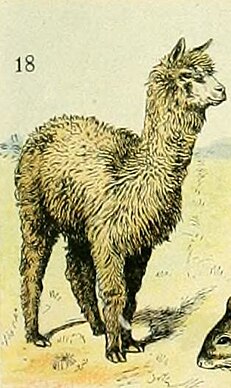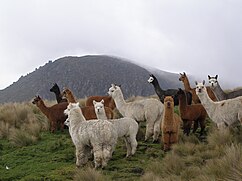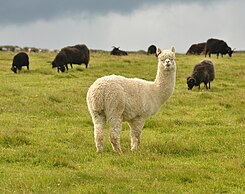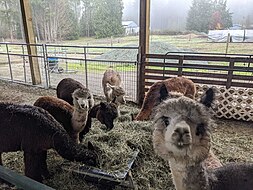56:
164:
117:(μm). The size of a micron in comparison to a meter is 1/1,000,000th of a meter and in comparison to an inch, it is 1/25,400th of one inch. Fiber with lower micron counts is favored, because as the diameter increases so does the likelihood that the fiber will tear. Micron counts below 30 μm are used to form percentages that can predict the comfort level of the wool when worn with 90% of fibers under 30 μm being scored as a 90% comfort factor. The most frequent fiber diameter in U.S. Huacayas is 30 μm.
106:
151:
infants called crias will defer to the alpha male when the herd is integrated. In livestock production, females and males are often separated to reduce unintentional breeding. In this case, a hierarchy among females will form based on age. The youngest alpaca will hold the lowest status and exhibit submissive body language when approached by a higher-ranking alpaca. This body language looks like a lowering of the head, flattening of the ears, and turning up of the tail.
205:
79:. The native homeland of the Huacaya is the Andean highlands of South America, called the Altiplano. It is 4,000 ft (1,200 m) above sea level and reaches into Peru, Chile, and Bolivia. In the 1980s, these Huacaya were imported to other countries including Australia, Canada, England, France, New Zealand, and the United States of America to set up alpaca industries internationally.
143:
125:
present in sheep wool, which averages between 60-127 degrees/mm, Huacaya fiber has a low crimp ranging from 15-52 degrees/mm with a mean of 32 degrees/mm. In the U.S., the most frequent crimp measurement for
Huacaya is 35 degrees/mm. A higher crimp measurement is associated with a heavier fleece, lower micron count, and greater uniformity and is valued in some alpaca shows.
64:
154:
Once the hierarchy is established, alpacas will settle into relationships between themselves and other alpacas they have contact with for long periods of time. Therefore, it is best for the animals' welfare not to separate familiar alpacas. These relationships can be identified by noticing if alpacas
288:
Insecticides, heavy metals, and mold are other poisons. Insecticide-sprayed pasture or grasses grown from soil polluted with lead, mercury, and copper are deadly to alpacas. Mold is most commonly encountered in moldy hay due to humidity, storage conditions, and wetness. Moldy hay should never be fed
150:
Alpacas are herd animals and will gather together in a large mass to retreat when confronted with a threat. A male leader, termed the alpha, will take responsibility for herd protection and will display defensive behaviors such as biting, bumping, or kicking in the face of danger. Female alpacas and
175:
Alpacas themselves can be used as guardian animals for sheep and goats. While they have a docile nature towards humans, they create strong bonds with other prey animals they don't find threatening and are very protective of these relationships. Alpacas can exhibit defensive behaviors in the face of
216:
Alpacas as livestock can be provided a free range of forages in the form of pasture grasses and legumes (alfalfa or clover hay). Protein and calcium levels are higher in hay than in grasses, which makes hay a nutritious addition to an alpaca's diet. Feeding alpacas grains is another way to provide
200:
Huacaya alpacas share digestive tract anatomy with their biological family, Camelidae. Camelids are herbivore ruminants classified into a special suborder, Tylopoda, because they only have three stomach compartments. They are not considered "true ruminants" like cattle, sheep, and goats which have
96:
The
Huacaya alpaca is described as having a "wavy and spongy look" to its fiber compared to its counterpart breed, the Suri, which has "straight fiber with no crimp". Ideally, the conformation of a Huacaya should be correctly balanced by having a neck and legs that are two-thirds the length of the
212:
Alpacas require a dry matter intake of 1.8% of their body weight. Dry matter intake refers to the amount of feed eaten minus the water weight of that feed. So, the only aspect that is being measured is the forage and not the water. This is important to consider when comparing dry feeds which have
171:
Common predators for alpacas include aggressive domesticated dogs, mountain lions, coyotes, wolves, black bears, grizzly bears, foxes, and eagles. The risk of attacks from these predators is higher in rural areas where wildlife habitats overlap with alpaca pasture. Guardian animals can be used to
124:
Huacayas have a fiber feature that is distinct from Suri alpacas called crimp which refers to the waviness of the fibers in the fleece. It is measured in degrees per millimeter with <50 degrees/mm defined as a low crimp and >100 degrees/mm defined as a high crimp. When compared to the crimp
120:
The length of
Huacaya fiber is measured in millimeters (mm). In the U.S., the most frequent fiber length for Huacayas is 100 millimetres (3.9 in). A longer fiber length will improve how well the wool is spun and is associated with increased strength and consistency. A minimum fiber length of
128:
There are 22 varieties of coat color recognized in
Huacaya alpacas including "black, brown, grey, caramel, red, fawn, and white". However, these categories don't reflect the reality that alpaca coats present themselves in a color gradient with appearances of unique patterns and speckles.
356:. There are similarly few vaccines for viral diseases in alpacas as there are bacterial vaccines. In the case of rabies, there is no treatment and the death rate is 100%. Prevention is a more effective method of addressing viral diseases and requires the quarantine of any sick animals.
121:
71–101 millimetres (2.8–4.0 in) is required for processing in a commercial mill. Many alpaca farmers shear their
Huacaya on a 12-month basis. Some farmers in South America shear their alpacas on a 14-16-month schedule to achieve higher fiber lengths.
217:
carbohydrates for energy, but not protein or minerals. This is why grains are better to be used as a small supplement to an alpaca's diet. Overfeeding grain can generate an excess of lactic acid in the alpaca's stomach in a process called acidosis.
336:
can be deadly, resulting in abortions or the death of alpacas that ingest the bacterial spores. For some bacterial infections, antibiotics can be given as treatment. However, in cases such as brucellosis, no vaccine has been developed for alpacas.
201:
four stomach compartments. Similar to true ruminants, camelids regurgitate swallowed food and chew on it to further break down the material. This act is referred to as remastication or chewing cud, and it makes camelids adept at digesting fiber.
87:
Huacayas far outnumber their counterpart breed, the Suri alpaca. There are more than 3.6 million alpaca in Peru alone, and
Huacaya alpacas make up 80% of that population. The worldwide alpaca population is estimated to be more than 90% Huacaya.
188:
because they have three compartments to their stomach, and their feet consist of two padded toes that end in claws. They only have incisors on the lower jaw which grind food against a dental pad on the roof of their mouths to chew.
579:
42:) that has a unique appearance and fiber quality. This breed is the most popular alpaca breed with population numbers reaching 2.8 million in Peru alone. They share biological components with other species in the
46:
family. Their digestive tract, nutrition requirements, and herd behavior mirror that of all camelids. They also survive amidst similar predation, poison, and disease threats that endanger all camelids alike.
445:
Figueroa, Deyanira; Corredor, Flor-Anita; Mamani-Cato, Ruben; Gallegos-Acero, Roberto; Condori-Rojas, Nicoll; Estrada, Richard; Heredia, Lizeth; Salazar, Wilian; Quilcate, Carlos; Arbizu, Carlos (2023).
371:. Treatment consists of the use of antifungal agents and topical ointments. The best preventative measure is to disinfect surface areas that sick alpaca have had contact with.
501:
961:
225:
When giving alpacas free range in pastures, it is important to take into account the possible poisonous plants they may have access to. Ornamental flowers such as the
155:
are grazing close to each other, resting with each other, or exchanging soft humming sounds often. These vocalizations are the alpacas' way of talking to each other.
297:
Alpacas are very susceptible to parasites due to their grazing when parasites attached to grasses and soil are orally ingested. Common parasites for alpacas include
192:
Huacaya young have a birth weight ranging from 8–23 pounds (3.6–10.4 kg) and grow into an adult weight of 105–108 pounds (48–49 kg).
680:
524:
172:
protect alpacas from predators including the use of a guard dog and the integration of llamas and donkeys into the herd.
870:
773:
594:
448:"Microsatellite-Based Genetic Diversity and Population Structure of Huacaya Alpacas (Vicugna pacos) in Southern Peru"
860:
717:
75:. Both breeds were first domesticated by the Incas thousands of years ago from a wild species of camelid, the
956:
936:
587:
Current Status of
Genetic Resources, Recording and Production Systems in African, Asian and American Camelids
941:
840:
502:"Investigation of the dyeing characteristics of alpaca fibers (Huacaya and Suri) in comparison with wool"
790:
425:
353:
654:
545:
946:
55:
951:
163:
17:
345:
230:
317:. Dewormer shots can be given and crop rotation utilized to reduce the risk for parasites.
97:
alpaca's back. As adults, the height up to their withers is 32–39 inches (81–99 cm).
8:
739:
474:
447:
910:
883:
764:
Cebra, Chris; Anderson, David; Tibary, Ahmed; Van Saun, Robert; Johnson, LaRue (2013).
599:. Proceedings of the ICAR/FAO Seminar on Camelids held in Sousse, Tunisia, 30 May 2004.
364:
329:
670:
614:
816:
769:
713:
630:
590:
479:
63:
931:
905:
895:
666:
626:
557:
516:
469:
459:
766:
Llama and Alpaca Care: Medicine, Surgery, Reproduction, Nutrition, and Herd Health
368:
349:
252:
900:
561:
710:
Guard
Animals for Livestock Protection Existing and Potential Use in Australia
925:
589:. ICAR Technical Series – no. 11. Rome: ICAR. pp. 31–36.
520:
431:. (With contributing authors). Santa Cruz, California (US): Bonny Doon Press.
360:
333:
71:
The
Huacaya alpaca is one of two breeds of alpaca, the other breed being the
483:
274:
248:
235:
105:
791:"The use of alpacas as new-born lamb protectors to minimise fox predation"
444:
325:
306:
282:
240:
213:<10% water content and pasture grass which has >80% water content.
72:
464:
264:
256:
244:
176:
canines they are unfamiliar with and will pursue and kick aggressors.
740:"Behavior Traits of Alpacas Based on Pasture and Stable Observations"
298:
278:
204:
43:
76:
821:
Alpaca Owners and
Breeder Association Annual Conference Proceedings
310:
302:
289:
to alpacas because while some molds are harmless, others can kill.
226:
185:
861:"Poisonings in Alpacas – Part 2: Garden plants and garden escapes"
848:. Santa Cruz, California (US): Bonny Doon Press. pp. 485–502.
768:(1st ed.). Missouri: Elsevier Health Sciences. pp. 6–7.
321:
341:
314:
114:
35:
285:
are dangerous and should be removed from an alpaca's pasture.
615:"Nutrition of Domesticated South American Llamas and Alpacas"
763:
184:
Huacayas are organized into a suborder of ruminants called
679:
McColl, Angus; Lupton, Chris; Stobart, Bob (Summer 2004).
142:
113:
Alpaca fiber is measured by its diameter in units called
962:
Mammal breeds originating from Indigenous Americans
884:"Important Ectoparasites of Alpaca (Vicugna pacos)"
678:
652:
839:
585:. In R. Cardellino; A. Rosati; C. Mosconi (eds.).
424:
737:
546:"Human ability to interpret alpaca body language"
543:
923:
418:
416:
414:
412:
410:
408:
406:
404:
681:"Fiber Characteristics of U.S. Huacaya Alpacas"
653:Lupton, C.J.; McColl, A; Stobart, R.H. (2006).
577:
402:
400:
398:
396:
394:
392:
390:
388:
386:
384:
788:
655:"Fiber characteristics of the Huacaya Alpaca"
612:
243:are toxic to alpacas. Certain shrubs such as
738:Kapustka, Joanna; Budzyńska, Monika (2018).
544:Kapustka, Joanna; Budzynska, Monika (2021).
381:
359:Fungal diseases that impact alpacas include
539:
537:
499:
530:on 2016-02-25 – via Wayback Machine.
423:Hoffman, Eric (2003). Eric Hoffman (ed.).
340:Common viral diseases for alpacas include
909:
899:
881:
831:
580:"Alpaca and vicuña: General perspectives"
473:
463:
648:
646:
644:
642:
640:
534:
203:
162:
141:
104:
62:
54:
837:
814:
707:
613:Martin, F. San; Brayant, F. C. (1989).
578:Aréstegui Otazú, Daniel (August 2005).
422:
14:
924:
495:
493:
810:
808:
789:Mahoney, Sara; Charry, A. A. (2005).
677:An edited version also published as:
637:
608:
606:
573:
571:
858:
733:
731:
729:
703:
701:
699:
673:– via Elsevier Science Direct.
633:– via Elsevier Science Direct.
564:– via Elsevier Science Direct.
440:
438:
255:are also poisonous. Weeds including
500:Atav, Riza; Türkmen, Faith (2015).
490:
137:
24:
805:
603:
568:
25:
973:
795:Extension Farming Systems Journal
726:
696:
671:10.1016/j.smallrumres.2005.04.023
435:
313:, mites, lice, ticks, and nasal
875:
852:
782:
757:
867:. No. 15. pp. 39–46.
859:Paul, Elizabeth (March 2021).
550:Journal of Veterinary Behavior
167:A Huacaya alpaca guards sheep.
67:A drawing of a Huacaya alpaca.
59:A picture of a huacaya alpaca.
13:
1:
888:Acta Veterinaria Scandinavica
374:
320:Bacterial diseases including
91:
82:
817:"Basics of Alpaca Nutrition"
631:10.1016/0921-4488(89)90001-1
158:
7:
901:10.1186/1751-0147-52-S1-S17
208:Huacaya alpacas eating hay.
132:
10:
978:
562:10.1016/j.jveb.2020.12.003
354:vesicular stomatitis virus
292:
220:
179:
844:. In Eric Hoffman (ed.).
846:The Complete Alpaca Book
521:10.1177/0040517514563727
509:Textile Research Journal
427:The Complete Alpaca Book
100:
50:
882:Bornstein, Set (2010).
815:Irlbeck, Nancy (2000).
708:Jenkins, David (2003).
659:Small Ruminant Research
619:Small Ruminant Research
195:
869: – via
841:"Chapter 23 – Poisons"
838:Hoffman, Eric (2003).
346:foot-and-mouth disease
209:
168:
147:
146:A Huacaya alpaca herd.
110:
68:
60:
207:
166:
145:
108:
66:
58:
957:Mammals of the Andes
937:Mammals of Argentina
109:Huacaya alpaca fiber
865:Camelid Connections
712:. NSW Agriculture.
690:. pp. 186–196.
465:10.3390/ani13091552
942:Mammals of Bolivia
365:coccidioidomycosis
210:
169:
148:
111:
69:
61:
515:(13): 1331–1339.
16:(Redirected from
969:
947:Mammals of Chile
916:
915:
913:
903:
879:
873:
868:
856:
850:
849:
843:
835:
829:
828:
812:
803:
802:
786:
780:
779:
761:
755:
754:
744:
735:
724:
723:
705:
694:
691:
688:Alpacas Magazine
685:
674:
650:
635:
634:
610:
601:
600:
584:
575:
566:
565:
541:
532:
531:
529:
523:. Archived from
506:
497:
488:
487:
477:
467:
442:
433:
432:
430:
420:
138:Social structure
21:
977:
976:
972:
971:
970:
968:
967:
966:
952:Mammals of Peru
922:
921:
920:
919:
880:
876:
857:
853:
836:
832:
813:
806:
787:
783:
776:
762:
758:
742:
736:
727:
720:
706:
697:
683:
651:
638:
611:
604:
597:
582:
576:
569:
542:
535:
527:
504:
498:
491:
443:
436:
421:
382:
377:
369:dermatophytosis
350:West Nile virus
330:Johne's disease
295:
253:Russian thistle
223:
198:
182:
161:
140:
135:
103:
94:
85:
53:
28:
27:Breed of alpaca
23:
22:
15:
12:
11:
5:
975:
965:
964:
959:
954:
949:
944:
939:
934:
918:
917:
874:
851:
830:
804:
781:
774:
756:
725:
718:
695:
693:
692:
665:(3): 211–224.
636:
625:(3): 191–216.
602:
595:
567:
533:
489:
434:
379:
378:
376:
373:
294:
291:
222:
219:
197:
194:
181:
178:
160:
157:
139:
136:
134:
131:
102:
99:
93:
90:
84:
81:
52:
49:
34:is a breed of
32:Huacaya alpaca
26:
9:
6:
4:
3:
2:
974:
963:
960:
958:
955:
953:
950:
948:
945:
943:
940:
938:
935:
933:
930:
929:
927:
912:
907:
902:
897:
893:
889:
885:
878:
872:
866:
862:
855:
847:
842:
834:
826:
822:
818:
811:
809:
800:
796:
792:
785:
777:
775:9781437723526
771:
767:
760:
752:
748:
741:
734:
732:
730:
721:
715:
711:
704:
702:
700:
689:
682:
676:
675:
672:
668:
664:
660:
656:
649:
647:
645:
643:
641:
632:
628:
624:
620:
616:
609:
607:
598:
596:92-95014-06-5
592:
588:
581:
574:
572:
563:
559:
555:
551:
547:
540:
538:
526:
522:
518:
514:
510:
503:
496:
494:
485:
481:
476:
471:
466:
461:
457:
453:
449:
441:
439:
429:
428:
419:
417:
415:
413:
411:
409:
407:
405:
403:
401:
399:
397:
395:
393:
391:
389:
387:
385:
380:
372:
370:
366:
362:
361:aspergillosis
357:
355:
351:
347:
343:
338:
335:
334:leptospirosis
331:
327:
323:
318:
316:
312:
308:
304:
300:
290:
286:
284:
280:
276:
272:
268:
267:
262:
258:
254:
250:
246:
242:
238:
237:
232:
231:African daisy
228:
218:
214:
206:
202:
193:
190:
187:
177:
173:
165:
156:
152:
144:
130:
126:
122:
118:
116:
107:
98:
89:
80:
78:
74:
65:
57:
48:
45:
41:
40:Vicugna pacos
37:
33:
19:
891:
887:
877:
864:
854:
845:
833:
824:
820:
798:
794:
784:
765:
759:
750:
746:
709:
687:
662:
658:
622:
618:
586:
553:
549:
525:the original
512:
508:
455:
451:
426:
358:
339:
319:
307:liver flukes
296:
287:
275:bracken fern
271:T. palustris
270:
265:
260:
249:rhododendron
236:Osteospermum
234:
224:
215:
211:
199:
191:
183:
174:
170:
153:
149:
127:
123:
119:
112:
95:
86:
70:
39:
31:
29:
458:(9): 1552.
326:brucellosis
283:death camas
266:T. maritima
241:arum lilies
239:spp.), and
233:(including
73:Suri alpaca
926:Categories
894:(1): S17.
753:: 128–136.
719:0734715455
375:References
261:Triglochin
257:arrowgrass
245:horsebrush
92:Appearance
83:Population
556:: 16–21.
303:tapeworms
299:lungworms
279:cocklebur
159:Predation
44:Camelidae
484:37174589
475:10177232
311:coccidia
227:geranium
186:Tylopoda
133:Behavior
932:Alpacas
911:2994293
747:Animals
452:Animals
322:anthrax
293:Disease
221:Poisons
180:Biology
115:microns
18:Huacaya
908:
772:
716:
593:
482:
472:
367:, and
352:, and
342:rabies
332:, and
281:, and
251:, and
77:vicuña
36:alpaca
743:(PDF)
684:(PDF)
583:(PDF)
528:(PDF)
505:(PDF)
263:spp.
259:(the
101:Fiber
51:Breed
871:Issu
801:(1).
770:ISBN
714:ISBN
591:ISBN
480:PMID
269:and
196:Diet
30:The
906:PMC
896:doi
667:doi
627:doi
558:doi
517:doi
470:PMC
460:doi
315:bot
273:),
928::
904:.
892:52
890:.
886:.
863:.
823:.
819:.
807:^
797:.
793:.
749:.
745:.
728:^
698:^
686:.
663:64
661:.
657:.
639:^
621:.
617:.
605:^
570:^
554:42
552:.
548:.
536:^
513:85
511:.
507:.
492:^
478:.
468:.
456:13
454:.
450:.
437:^
383:^
363:,
348:,
344:,
328:,
324:,
309:,
305:,
301:,
277:,
247:,
229:,
914:.
898::
827:.
825:4
799:1
778:.
751:3
722:.
669::
629::
623:2
560::
519::
486:.
462::
38:(
20:)
Text is available under the Creative Commons Attribution-ShareAlike License. Additional terms may apply.





